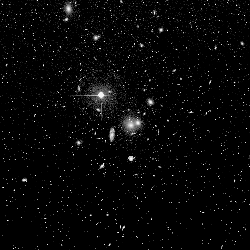The Lives of Galaxy Clusters: A Summary
Some of the big questions pondered by cosmologists today are about how the universe formed: "If everything started with the Big Bang, when things were very hot and very smooth, how did things become clumpy?" "How did stars start to form?" "How did Galaxies start to form?" These questions are some of the most basic, but also some of the hardest to answer. It has been billions of years since the Big Bang, and even since the first galaxies formed. How can we look at what we can see now and guess at what came before?
One place we look to for answers to these questions is clusters of galaxies. Galaxy clusters are huge: some may be more than ten million light years across and contain thousands of galaxies. In many cosmological models, these massive clusters form from smaller, more common clusters of galaxies. If this is true then galaxy clusters from long ago should be smaller on average than younger clusters. The " mass function" (which describes the number density of clusters as a function of mass) should change in a particular way over time. But how can you look at clusters from "long ago?" The answer is that because light travels at a finite speed, the light from some things that we see now left them millions of years ago. And because the Universe is expanding, light such as this is redshifted; the more redshift, the longer the light has traveled to reach us. By observing very high redshift objects, we can look back in time.
Of course, one problem is that it is not very easy to look at objects at very high redshifts (they tend to be very dim). This is especially true if you need a large statistical sample, such as one to make a general statement about a trend in the size of galaxy clusters over long times. Such a "trend" is only believable if you observe it for lots and lots of clusters.
Tackling the Question
Our research group uses X-ray observations to develop surveys of clusters of galaxies and their total X-ray luminosity function (XLF). The total X-ray luminosity function of a cluster is much easier to measure than its MF, but it's a lot more complicated to interpret. To measure the XLF of clusters, the Wide Angle ROSAT Pointed Survey (WARPS) was begun at Goddard Space Flight Center. WARPS covers a small area of the sky (and hence fewer rich clusters), but maps down to very low luminosities. To compile this survey, we use data from the ROSAT satellite.
What Do Cluster Surveys Show?
Another cluster XLF survey, the Einstein Extended Medium Sensitivity Survey (EMSS), seems to show that there was almost no difference in the XLFs of clusters with z > 0.3 and those with z < 0.3. At the high end of the luminosity function, there was the hint of a trend towards fewer high-luminosity (more massive) clusters at redshifts greater than 0.3. This is the opposite of what we expected based on the simplest cosmological models, which predict that there should be more high luminosity clusters at earlier times in the XLF.
What does the future hold? WARPS is an ongoing project and is only partially completed. When finished, we can use it to quantify the evolution or lack thereof in the XLF for low-luminosity clusters.
WARPS and surveys like it also provide a sample of clusters to use as input for future studies by X-ray missions like Chandra X-ray Observatory and XMM. These mission will be able to measure the X-ray temperatures of clusters even at high redshift. Measuring the temperature of clusters will allow determination of the temperature function (TF) of clusters. Temperature is much more simply related to mass than luminosity and avoids many complications like energy injection by early supernovae. Comparing evolution of the high and low redshift TFs will allow for a much better constrains on cosmological models.
Thank you to Don Horner for contributing to this article.



